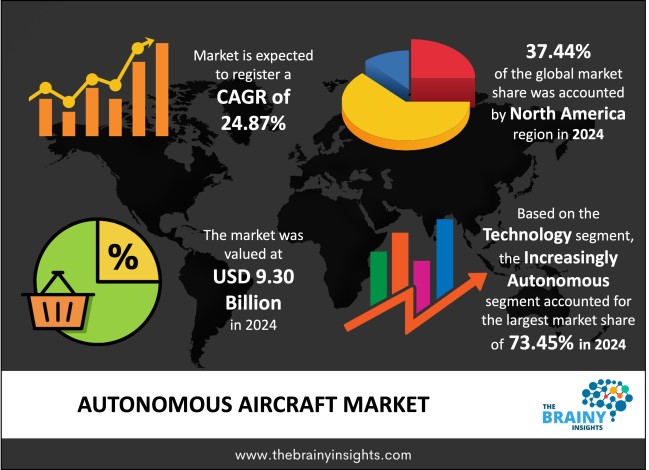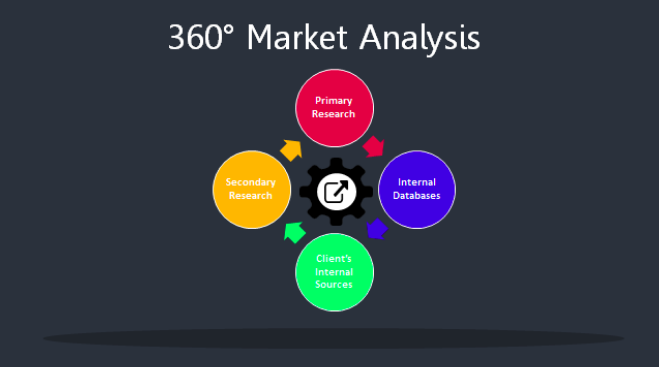- +1-315-215-1633
- sales@thebrainyinsights.com

The global Autonomous Aircraft market was valued at USD 9.30 Billion in 2024 and grew at a CAGR of 24.87% from 2025 to 2034. The market is expected to reach USD 85.73 Billion by 2034. The market is driven by factors like the aviation industry being completely or highly automated by the 2040s. It then opens up new ways of operating and new business models, making flying more accessible compared to the present time. Autonomy helps decrease costs and improve the operations and utilisation of aircraft. It will help in better use of the airspace. More autonomy will alleviate the significant pilot shortage problem, which can become more severe with the introduction of new advanced air mobility (AAM) vehicles, such as electric regional aircraft and air taxis. There is an estimate that over 600,000 pilots will need to be trained in the next two decades.
It has been observed that autonomous and highly automated aircraft are now moving the cargo back and forth. Additionally, the military has been utilising remotely piloted UAS (Unmanned Aircraft System) platforms to carry supplies for over a decade. Commercially, delivery drones are regularly transporting cargo of all types safely and seamlessly from one point to another. It seems like, in some time, these autonomous drones will offer regular home delivery of groceries, prescriptions and other important items. For instance, Nuvva 300 aircraft from Textron’s Pipistrel, which has the capability of carrying 1000 pounds of cargo for a distance of over 180 miles, can be of great use in the future. It will be operated remotely by someone on the ground using an advanced satellite communication system and autonomous navigation software, among other technologies. Autonomous aircraft are transforming the aviation sector through the integration of artificial intelligence, automated flight control systems, and advanced sensors. These aircraft can be operated with fewer or no human interventions, which can improve efficiency, safety, and cost-effectiveness. There appears to be tremendous potential for the market due to growing demand in the defence, logistics, and commercial sectors. Leading organisations in the market are investing heavily in R&D to enhance autonomous flight capabilities, with a focus on cargo transport and urban air mobility.
These autonomous aircraft are modern aircraft that can be operated without direct human intervention, and they largely depend on sensors, artificial intelligence (AI), and onboard computing systems for navigation and performing tasks. These aircraft can operate with minimal or no human input and, thus, are suited for various applications, including military, commercial, and cargo operations. These aircraft feature advanced technologies, including the use of AI and ML, which enable decision-making, adaptive flight planning, and obstacle avoidance. It also features advanced sensors and navigation systems, which utilise LIDAR, GPS, RADAR, and computer vision for real-time situational awareness. Its automated flight control provides the capability of take-off, landing, and cruising, as well as emergency landing, with the requirement for human intervention. It uses satellite links, cloud computing and 5G for seamless operation and remote monitoring. These are also equipped with cybersecurity protocols, failsafe mechanisms and a backup system for reliability. It can be used for various applications in the future, such as future taxis, cargo transport, and passenger aircraft, with reduced pilot input. In the military and defence sector, it can be of great use in reconnaissance, combat drones, surveillance and autonomous fighter jets. It is useful as autonomous freight carriers and drone delivery services. It looks promising for pesticide spraying, crop monitoring, and precision farming. It can be very useful for search and rescue operations, wildfire monitoring and medical supply deliveries.

Get an overview of this study by requesting a free sample
Growing use of AIs– AI is playing a pivotal role in the autonomous aircraft sector, as it has enabled it with advanced flight control and navigation capabilities. It also helps in operational efficiency. These aircraft will feature AI-powered systems that can process real-time data from GPS, sensors, and LiDAR to enhance autonomous takeoff, landing, and flight path optimisation. Computer vision plays a crucial part in detecting and avoiding obstacles. Predictive maintenance systems play a crucial role in analysing and preventing any type of failure, thereby decreasing downtime. They help improve air traffic management by optimising airspace use and offering seamless communication with air traffic control. Additionally, in emergencies, AI-driven autopilot systems can make real-time decisions, such as rerouting flights or initiating safe landings. AI also help strengthen cybersecurity through the detection and prevention of hacking threats. Thus ensuring secure data transmission between aircraft and ground stations. There has been a rapid advancement in AI-driven aviation, especially in cargo transport, urban air mobility and unmanned aerial vehicles for Defence and logistics. These factors will eventually propel the growth of the Autonomous Aircraft market.
Regulatory issues – There are very complex and evolving regulatory scenarios that are acting as hindrances to the market's growth. Also, aviation bodies are still making certification processes and safety guidelines for autonomous systems. Additionally, the development and integration of the autonomous system can be costly, requiring further investment in maintenance and operations. Moreover, AI and machine learning are experiencing rapid growth. However, there are still limitations in many areas, such as complex weather conditions or unpredicted situations where the presence of human pilots can be much more effective. All these factors are acting as restraints for the market.
Advancement in technology – Advancements in technology are happening, and with that, AI-powered flight management systems, real-time data analytics, and collision avoidance algorithms are enhancing the dependability and safety of autonomous aircraft. Governments of the leading countries are also increasing the defence budgets to include smart unmanned systems which are capable of performing high-risk missions. Additionally, the demand for Air taxis and short-distance autonomous air travel is driving innovations in passenger drones, among other developments. Moreover, autonomous aircraft can lead to lower operational costs by eliminating pilot requirements, decreasing human error, and optimising fuel consumption through smart routing. There is a growing focus on urban air mobility solutions, such as air taxis and drone deliveries. There is increasing demand for automated air cargo transport along with the integration of AI in traffic management. All these factors are increasing the demand for the use of Autonomous Aircraft in the forecasting period.
The regions analysed for the market include North America, Europe, South America, Asia Pacific, the Middle East, and Africa. North America emerged as the most significant global Autonomous Aircraft market, with a 37.44% market revenue share in 2024.
The North American region leads the Autonomous Aircraft market as leading aircraft vendors are present in the region. Also, there is a growing demand for autonomous aircraft in the US military. Additionally, there is significant investment in R&D and robust technological innovation occurring alongside a supportive regulatory environment in the US. Additionally, there is a greater focus on the development of technology by organisations such as Alphabet’s Wing and Amazon. These factors are creating a high demand for Autonomous Aircraft in the region.
North America Region Autonomous Aircraft Market Share in 2024 – 37.44%
www.thebrainyinsights.com
Check the geographical analysis of this market by requesting a free sample
The technology segment is divided into increasingly autonomous and fully autonomous. Increasingly autonomous segment dominated the market, with a market share of around 73.45% in 2024. This significant share is attributed to advancements in sensor technology, machine learning, and AI, which enable the aircraft to perform complex tasks autonomously, such as decision-making in various operational situations, obstacle avoidance, and navigation. Autonomous systems enhance efficiency, safety, and operational flexibility in both military and commercial scenarios.
The end user segment is divided into cargo aircraft, combat & ISR, medical services, passenger aircraft and others. The cargo aircraft segment dominated the market, with a market share of around 41.45% in 2024. This significant share is due to the growing need for cost-effective and efficient solutions. Autonomous technology is helping to reduce human error. It also improves the operational efficiency and lowers the transportation costs. Moreover, autonomous aircraft can efficiently operate in remote and challenging conditions without the need for human pilots, which ultimately expands the range of cargo delivery.
| Attribute | Description |
|---|---|
| Market Size | Revenue (USD Billion) |
| Market size value in 2024 | USD 9.30 Billion |
| Market size value in 2034 | USD 85.73 Billion |
| CAGR (2025 to 2034) | 24.87% |
| Historical data | 2021-2023 |
| Base Year | 2024 |
| Forecast | 2025-2034 |
| Region | The regions analyzed for the market are Asia Pacific, Europe, South America, North America, and Middle East and Africa. Furthermore, the regions are further analyzed at the country level. |
| Segments | Technology and End User |
As per The Brainy Insights, the size of the global Autonomous Aircraft market was valued at USD 9.30 billion in 2024 to USD 85.73 billion by 2034.
Global Autonomous Aircraft market is growing at a CAGR of 24.87% during the forecast period 2025-2034.
The market's growth will be influenced by growing use of AIs.
Regulatory issues could hamper the market growth.
This study forecasts revenue at global, regional, and country levels from 2021 to 2034. The Brainy Insights has segmented the global Autonomous Aircraft market based on below mentioned segments:
Global Autonomous Aircraft Market by Technology:
Global Autonomous Aircraft Market by End User:
Global Autonomous Aircraft Market by Region:
Research has its special purpose to undertake marketing efficiently. In this competitive scenario, businesses need information across all industry verticals; the information about customer wants, market demand, competition, industry trends, distribution channels etc. This information needs to be updated regularly because businesses operate in a dynamic environment. Our organization, The Brainy Insights incorporates scientific and systematic research procedures in order to get proper market insights and industry analysis for overall business success. The analysis consists of studying the market from a miniscule level wherein we implement statistical tools which helps us in examining the data with accuracy and precision.
Our research reports feature both; quantitative and qualitative aspects for any market. Qualitative information for any market research process are fundamental because they reveal the customer needs and wants, usage and consumption for any product/service related to a specific industry. This in turn aids the marketers/investors in knowing certain perceptions of the customers. Qualitative research can enlighten about the different product concepts and designs along with unique service offering that in turn, helps define marketing problems and generate opportunities. On the other hand, quantitative research engages with the data collection process through interviews, e-mail interactions, surveys and pilot studies. Quantitative aspects for the market research are useful to validate the hypotheses generated during qualitative research method, explore empirical patterns in the data with the help of statistical tools, and finally make the market estimations.
The Brainy Insights offers comprehensive research and analysis, based on a wide assortment of factual insights gained through interviews with CXOs and global experts and secondary data from reliable sources. Our analysts and industry specialist assume vital roles in building up statistical tools and analysis models, which are used to analyse the data and arrive at accurate insights with exceedingly informative research discoveries. The data provided by our organization have proven precious to a diverse range of companies, facilitating them to address issues such as determining which products/services are the most appealing, whether or not customers use the product in the manner anticipated, the purchasing intentions of the market and many others.
Our research methodology encompasses an idyllic combination of primary and secondary initiatives. Key phases involved in this process are listed below:

The phase involves the gathering and collecting of market data and its related information with the help of different sources & research procedures.

The data procurement stage involves in data gathering and collecting through various data sources.
This stage involves in extensive research. These data sources includes:
Purchased Database: Purchased databases play a crucial role in estimating the market sizes irrespective of the domain. Our purchased database includes:
Primary Research: The Brainy Insights interacts with leading companies and experts of the concerned domain to develop the analyst team’s market understanding and expertise. It improves and substantiates every single data presented in the market reports. Primary research mainly involves in telephonic interviews, E-mail interactions and face-to-face interviews with the raw material providers, manufacturers/producers, distributors, & independent consultants. The interviews that we conduct provides valuable data on market size and industry growth trends prevailing in the market. Our organization also conducts surveys with the various industry experts in order to gain overall insights of the industry/market. For instance, in healthcare industry we conduct surveys with the pharmacists, doctors, surgeons and nurses in order to gain insights and key information of a medical product/device/equipment which the customers are going to usage. Surveys are conducted in the form of questionnaire designed by our own analyst team. Surveys plays an important role in primary research because surveys helps us to identify the key target audiences of the market. Additionally, surveys helps to identify the key target audience engaged with the market. Our survey team conducts the survey by targeting the key audience, thus gaining insights from them. Based on the perspectives of the customers, this information is utilized to formulate market strategies. Moreover, market surveys helps us to understand the current competitive situation of the industry. To be precise, our survey process typically involve with the 360 analysis of the market. This analytical process begins by identifying the prospective customers for a product or service related to the market/industry to obtain data on how a product/service could fit into customers’ lives.

Secondary Research: The secondary data sources includes information published by the on-profit organizations such as World bank, WHO, company fillings, investor presentations, annual reports, national government documents, statistical databases, blogs, articles, white papers and others. From the annual report, we analyse a company’s revenue to understand the key segment and market share of that organization in a particular region. We analyse the company websites and adopt the product mapping technique which is important for deriving the segment revenue. In the product mapping method, we select and categorize the products offered by the companies catering to domain specific market, deduce the product revenue for each of the companies so as to get overall estimation of the market size. We also source data and analyses trends based on information received from supply side and demand side intermediaries in the value chain. The supply side denotes the data gathered from supplier, distributor, wholesaler and the demand side illustrates the data gathered from the end customers for respective market domain.

The supply side for a domain specific market is analysed by:
The demand side for the market is estimated through:
In-house Library: Apart from these third-party sources, we have our in-house library of qualitative and quantitative information. Our in-house database includes market data for various industry and domains. These data are updated on regular basis as per the changing market scenario. Our library includes, historic databases, internal audit reports and archives.
Sometimes there are instances where there is no metadata or raw data available for any domain specific market. For those cases, we use our expertise to forecast and estimate the market size in order to generate comprehensive data sets. Our analyst team adopt a robust research technique in order to produce the estimates:
Data Synthesis: This stage involves the analysis & mapping of all the information obtained from the previous step. It also involves in scrutinizing the data for any discrepancy observed while data gathering related to the market. The data is collected with consideration to the heterogeneity of sources. Robust scientific techniques are in place for synthesizing disparate data sets and provide the essential contextual information that can orient market strategies. The Brainy Insights has extensive experience in data synthesis where the data passes through various stages:


Market Deduction & Formulation: The final stage comprises of assigning data points at appropriate market spaces so as to deduce feasible conclusions. Analyst perspective & subject matter expert based holistic form of market sizing coupled with industry analysis also plays a crucial role in this stage.
This stage involves in finalization of the market size and numbers that we have collected from data integration step. With data interpolation, it is made sure that there is no gap in the market data. Successful trend analysis is done by our analysts using extrapolation techniques, which provide the best possible forecasts for the market.
Data Validation & Market Feedback: Validation is the most important step in the process. Validation & re-validation via an intricately designed process helps us finalize data-points to be used for final calculations.

The Brainy Insights interacts with leading companies and experts of the concerned domain to develop the analyst team’s market understanding and expertise. It improves and substantiates every single data presented in the market reports. The data validation interview and discussion panels are typically composed of the most experienced industry members. The participants include, however, are not limited to:
Moreover, we always validate our data and findings through primary respondents from all the major regions we are working on.
Free Customization
Fortune 500 Clients
Free Yearly Update On Purchase Of Multi/Corporate License
Companies Served Till Date